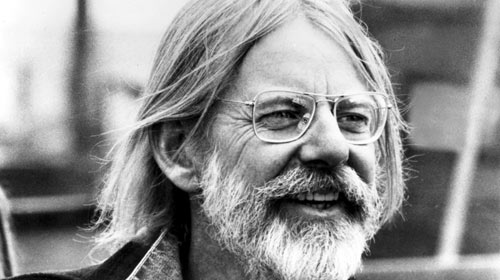I don’t know if Hal Ashby is in serious danger of being forgotten. But judging by the scant attendance at two recent press screenings for an ongoing retrospective at the Brooklyn Academy of Music (now playing through May 24th), I suspect that the cineastes are tired of talking him up. And that’s really a goddam shame. I certainly don’t know anybody under 40 who speaks of Hal Ashby with the same gusto devoted to such active 1970s directors as Brian De Palma, Martin Scorsese, Stanley Kubrick, or even William Friedkin and Walter Hill. (They’re certainly not going to bring up Joan Micklin Silver or Gillian Armstrong. But I’ll save comments on this regrettable gender disparity for another essay.) But like Alan J. Pakula, the recently departed Sidney Lumet, and Bob Rafelson, Hal Ashby often gets taken for granted.
Ashby began his career as an editor, winning an Oscar for his work on In the Heat of the Night in 1967. Three years later, Norman Jewison told Hal Ashby that he was a director. Jewison produced Ashby’s first feature, The Landlord — an iconoclastic, hard-to-find, zany, and one-of-a-kind satire written by Bill Gunn in which a Southern gentleman (Beau Bridges) becomes the landlord of a tenement building (in the now gentrified Park Slope) and has an affair with one of his tenants. (Her boyfriend is involved with the black power movement.)
The Landlord is filled with scenes (starting at around the 0:50 mark in the above clip) where the wild premise, which deals with race, white guilt, and false notions of entitlement, is topped by something out of left field. In this case, the kid not only blackmails Bridges’s milquetoast landlord for two dollars, but, after securing the two bucks, he offers the landlord a cigarette and lights up one for himself. Yet Ashby stages the scene so innocuously — complete with the kid ordering, “Home, landlord!” — that it deflates any potential discomfort and allows the audience to confront and enjoy the behavior.
Ashby’s third film, The Last Detail, continues in this vein. The film follows two US Navy sailors played by Jack Nicholson and Otis Young, escorting the young sailor Randy Meadows (Randy Quaid) to a naval prison. Meadows has received a harsh eight-year sentence for the minor crime of stealing $40. So the two sailors decide to show Meadows a good time. Ashby decided to direct Robert Towne’s razor-sharp and beautifully profane script in chronological order, traveling the same route as the sailors. This not only allowed the inexperienced Quaid and Young to get their sea legs over the course of the production, but it encouraged the magnetic naturalism that we see in the moment above. Watch the way Ashby neatly aligns the sailors by height or the way Nicholson slaps himself on the side of the head, foreshadowing the great explosive moment.
To some degree, you could call Hal Ashby a faithful chronicler of very recent history. Bound for Glory, his faithful biopic of Woody Guthrie, is his only real period piece, but it’s also the first movie to use the Steadicam. But Ashby was very concerned with recent events. Consider the way in which 1975’s Shampoo reckons with 1968’s sexual politics or the manner in which 1978’s Coming Home approaches the same year from the vantage point of the Vietnam War, taking the interesting step of casting Jane Fonda (who protested the war) as a very believable military wife who sees her world change when she meets a disabled Vet played by Jon Voight. It’s possible that The Social Network‘s recent success had much to do with similar revisitations of recent history. But is there any director working today capturing the last ten years the way that Ashby did?
Ashby worked so close with his actors that he often had them work on the scripts. Warren Beatty co-wrote Shampoo. No doubt his womanizing added some authenticity to the hairdresser juggling numerous paramours. 1982’s Lookin’ to Get Out, in which Ashby fought the studios for final cut, was co-written by Jon Voight. The original version of this film, as cut by Hal Ashby and as discovered in 2009, is playing as part of the retrospective. While there’s a gripping showdown in a casino club room, and some thespic chemistry between Voight and Burt Young (including one great early moment where Voight plays the scene spooning soup from a can as his character confesses losing a great deal of money), the film suffers from an implausible storyline and too many incoherent moments.
Did Hal Ashby lose his artistic chops in the Reagan era? I don’t think so. The above confrontation between Jeff Bridges and Andy Garcia in 1986’s 8 Millions Way to Die (this underrated film has become so maligned over the years that I was truly shocked to see it in the BAM lineup) demonstrated that Ashby could take something as innocuous as snow cones and turn it into a quirky tension builder. It’s the little tics that build this scene: Garcia moving to straighten his tie, Garcia’s lieutenant hovering in the back, and Bridges curling his fingers just after taking a bite. But when Garcia explodes at Bridges, the moment is especially startling because of how tightly framed the three men are, along with the overlapping chatter. I also love the way Garcia dispenses with his snow cone (similar to the way he kills the cigarette at the beginning of the scene; this is a character who always needs to have something in his hands to destroy). Oliver Stone’s dialogue in this scene is a bit silly (“My fault. I’m sorry. I didn’t get laid today.”), but can one imagine such blocking and gestures in movies today? Every time I see this juicy scene, I want to tear every goddam kid away from making CGI movies on his computer and force them to work with the nuts and bolts of human nuance.
